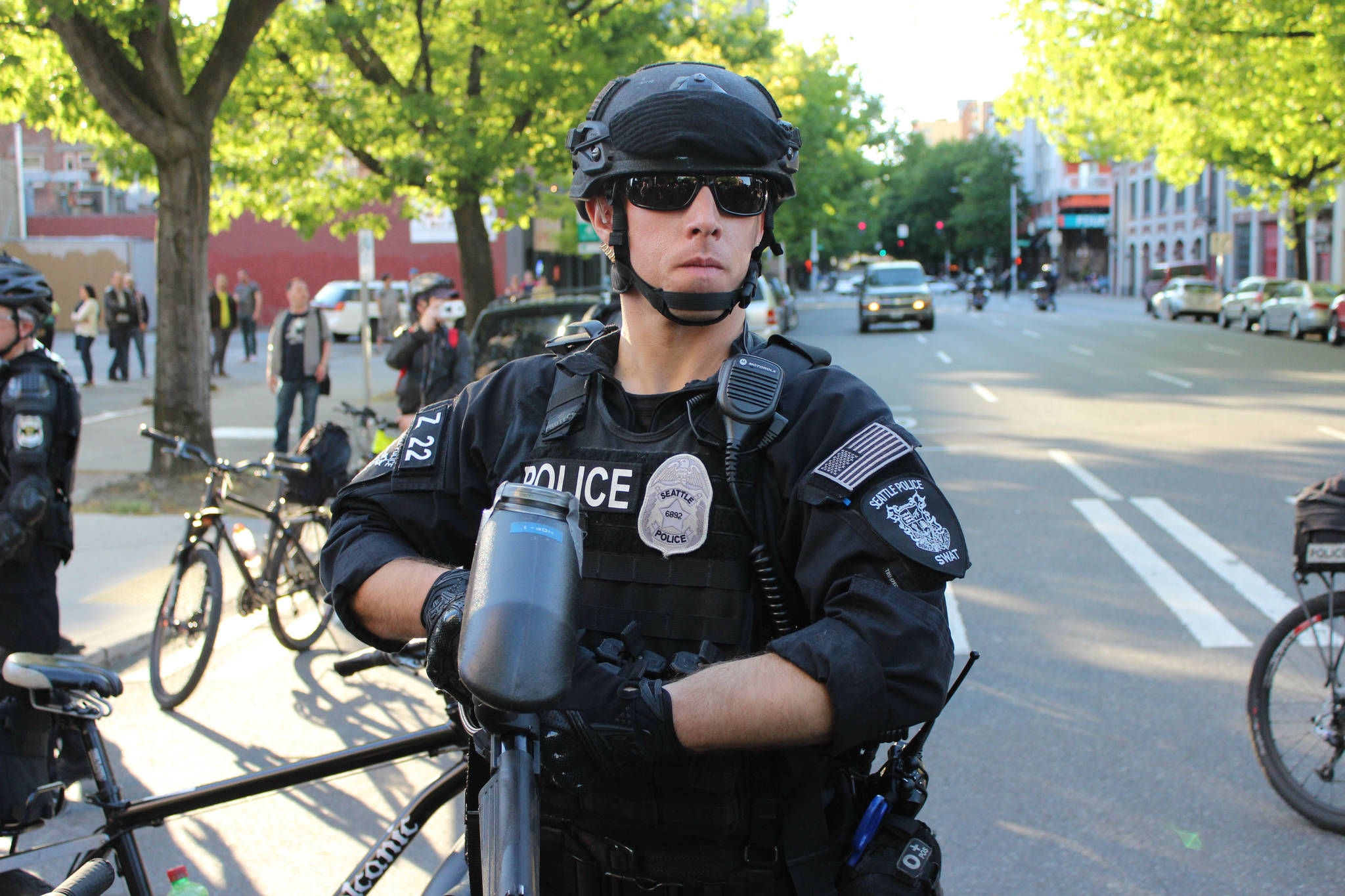Remember Mayor Ed Murray’s “safe lots” for RVs? The plan was to create specific locations where people living in recreational vehicles could park for more than three days at a time, which is typically how often they have to move to avoid parking citations on city streets. The project mostly fizzled out last year after staggering cost overruns, though there is still one operating at or near capacity in SoDo.
On Thursday, a group of RV campers moved into a vacant property in southwest Seattle belonging to the state Department of Transportation. Their goal is to create an organized, sustainable community that doesn’t suffer from the trash or violence many people associate with homeless encampments. Most or all of the camp denizens have been evicted from other campsites previously. City authorities say this new camp is in an inappropriate location, but it’s also not a priority for immediate removal in comparison to some other unauthorized camps. According to a camper I spoke to, there are about 20 RVs on site as of Monday morning, as well as a van and some cars.
The situation bears a striking resemblance to the genesis of Camp Second Chance, which lies about a mile and a half due south of the WSDOT site. Today, C2C is an authorized, city-sponsored encampment moving people into housing. But a little less than a year ago, after bouncing around between other sites, the upstart encampment faced impending eviction by city authorities. By organizing to keep the site safe and tidy, the C2C campers were able to garner enough support in the media and among elected officials to get a stay of eviction, and eventually city sponsorship.
The RV campers at the WSDOT site hope to emulate that strategy. But who are they? And where did they come from?
One month ago, Rebecca Massey needed help moving her car. It’s a battered old sedan that doesn’t run. With the help of a burly mechanic hired by Union Gospel Mission, Massey was able to pull her car out of the dirt rut in which it was parked, beneath the West Seattle Bridge. Massey was moving because city authorities were evicting her and all the other campers in Trollsville, as they called their home:
After fleeing Trollsville, Massey and other campers moved their cars, trailers, and RVs to a side-street near Spokane Street and some railroad tracks in SoDo. They were hoping that these new sites were well-enough hidden and insulated from residential housing to avoid eviction. But it was not to be. On Monday last week, Seattle police posted 72 hour notice for the campers to move along. Many of the vehicles, like Massey’s, do not run and had to be towed, according to campers.
“We tried to find a property where we would be off the streets, where we wouldn’t have to abide by that 72 hour rule,” said Massey Thursday afternoon.
The location they moved those vehicles to is the WSDOT property in southwest Seattle, near the First Avenue South Bridge. It’s a muddy field, mostly empty but for some piles of what looks like scrap material—sections of giant pipe, stacks of metal blocks. And now there are also about 20 RVs. The entire area is surrounded by fencing and trees except for one gated entrance. It’s an industrial area, with no nearby homes. Nearly a decade ago, the same site hosted the original Nickelsville for two months, according to SHARE.
Although the site belongs to WSDOT, Sgt. Courtney Stewart with the Washington State Patrol said Thursday that “we’ve basically given jurisdiction to the city” in terms of handling the RV campers. According to Seattle Human Services Department spokesperson Julie Moore, the WSDOT site isn’t “an appropriate place” for the RVs, but city eviction teams won’t prioritize it for removal. “The Navigation Team visited the site to assess the situation this morning,” said Moore via email Friday. “The City prioritizes encampment removals based on several issues, including health and safety. The City has been focusing its efforts on mitigating the most hazardous encampments.” The criteria for “most hazardous,” she said, include whether there are tents, the physical safety of the location, trash, hazardous structures, “negative behaviors,” and public health threats. Moore said that for the next two weeks, city eviction teams will concentrate on camps along I-90 and Rainier Avenue/Dearborn Street.
After driving up in his revamped RV Thursday, Matt Irvin worked with his dad to set up a tent by the front gate of the encampment that Irvin says will work as a security checkpoint. He says he’s been living on the streets, and occassionally in the Jungle (until someone tried to kill him with a machete, he says), since he lost his job as a machinist after the 2008 financial crash.
Over the past two months, Irvin estimates that he’s been evicted by auhorities “probably 15 times. It’s like having to clear out of a hotel room.”
Irvin’s father has a white mustache and the no-nonsense bearing of a lifetime blue collar worker. He says he came out to help his son. “Nobody would care that they were here,” says Irvin’s father, referring to unauthorized homeless encampments in Seattle generally, “… if they wouldn’t throw their garbage everywhere.” He also blames authorities for displacing campers from the Jungle into surrounding neighborhoods last year. “Shutting it down, that just pushed them out everywhere,” he says.
Tracy Olson is a vehicle camper who was still in SoDo Thursday evening, after most campers had already moved to the muddy WSDOT property. A tiny dog’s head stuck out of the front of her jacket, where she held it and covered its ears when a train came past. “Why we leave messes,” she said, “is because [authorities] scare us and make us move fast. If we didn’t have to move [out of the site] fast, we’d pick it up. If there was dumpsters …we’d put our garbage away.”
Campers at the WSDOT property say their goal is to organize into a self-policing community based on shared rules, rather than devolving into the anarchic squalor that devoured the Field. Gizmo—a middle aged man who, like Massey, was evicted from Trollsville last month and from SoDo last week—hopes that the isolated location of the camp will make it more palatable to traditional opponents of homeless campers.
“If we can get the people in Seattle who are tired of people parking in their neighborhoods with RVs or people camping in their local park, they would maybe support us,” says Gizmo. “If it’s not here, we’re going to start getting pushed out into residential neighborhoods.”
We interviewed Paige Conca last year, when she was living in the Jungle where she cared for a friend. Once authorities opened up the nearby Field as a dumping ground for refugees from the Jungle, Conca voluntarily moved in. Since they evicted the Field in March, Conca says, “I’ve been bouncing around … just trying to find places I can stay with somebody.” Now—or at least as of Thursday afternoon—she is living in the back of Gizmo’s van, parked in that muddy WSDOT property in southwest Seattle. All of the campers I spoke to are hoping they’ve found somewhere they can stay for a while.
It’s been a while since they found such a place. Michelle, a 45-year-old camper who did not want to give her last name, says that she’s been living in an RV for two years with her husband. “We were relatively fine there for almost four months, but now we have to move every 72 hours,” she says. Megan Miller lives in her RV with at least one kitten. She says during one six-month period, “I had to move a good, like, twenty times. … There was one time when I got posted on an hour after I got there.”
Thursday’s sweep in SoDo wasn’t a sweep, technically. That is, the normal homeless encampment eviction process carried out by Seattle police and a few other executive departments did not occur. The mayor’s Navigation Team did not show up, nor did counselors from REACH.
So what happened? Parking violations. Seattle police officers posted 72-hour notices on vehicles in SoDo on Monday morning. The notices warned that if campers didn’t get out by Wednesday, their vehicles would be impounded.
“There was no encampment cleanup effort going on in SoDo [last] week displacing these individuals, as has been suggested,” said HSD’s Moore via email. “Any notices about RVs needing to move would have been issued by SPD parking enforcement.” Rather than clearing out SoDo, she points out, the city’s Navigation Team is currently busy clearing out encampments along I-90 near Sturgus Park.
Camper Thiago Cross, who also bounced from Trollsville to SoDo to now the WSDOT property, isn’t satisfied with that answer. He suggests that this kind of parking notice blitz gives Seattle authorities a loophole for getting around normal homeless camp eviction rules. “They’re subverting their own policy by saying ‘This has nothing to do with sweeps,’ but it’s a sweep,” he said. “It’s technically not a sweep, but it’s a sweep.”
On Friday, the presiding judge at Seattle Municipal Court disagreed with a variation of that argument. Judge Karen Donahue rejected legal arguments from a homeless man who argued that Seattle violated his constitutional rights by towing his broken but fixable pickup truck, one week after SPD placed a 72 hour notice to move it. The man “spent part of the early morning hours of October 13 trying to make a shelter” with some tarps and bicycles, then gave up and went to a homeless shelter. Donahue ruled that because the man could have moved his truck (either by fixing it or getting help pushing it) to another block, he chose to violate city parking laws and is subject the same sanctions as anyone else. An attorney with one of the firms representing the man says they expect to appeal the ruling.
Here’s a map of some of the places the RV campers now at the WSDOT site have bounced between since Mayor Ed Murray evicted the Jungle last year:
cjaywork@seattleweekly.com
This article originally misidentified the judge as federal judge James P. Donahue.








